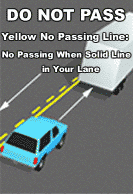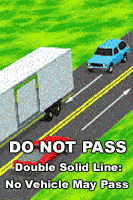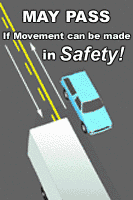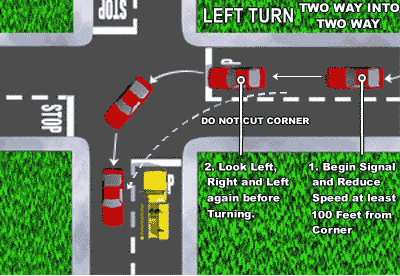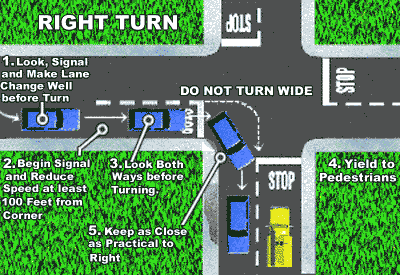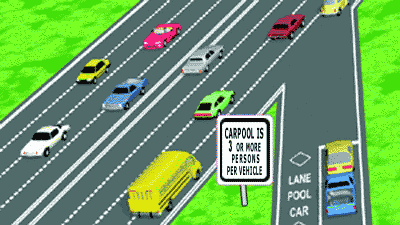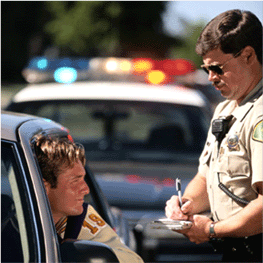Cal-Driver-Ed.Com |
|
California's Home Study Driver Education Class |
To easily find this site again, hit Ctrl+D, or drag this link: Cal-Driver-Ed to your Favorites.
| Log-In | Driver Education | Driver Training | DMV Requirements | FAQs | Compare | Contact Us |
|
The California DMV Driver Handbook |
|||||||||
Yellow lines mark the center of a road used for two-way traffic. You may pass on a two-way road if the yellow center line is broken. When a solid and a broken yellow line are together, you must not pass if you are driving next to the solid line. Two solid yellow lines mean “no passing.” Never drive to the left of these lines unless: • You are turning left at an intersection or into or out of a private road or driveway. • The right half of the road is closed or blocked. • You are in carpool lanes with designated entrances on the left.
(1) Solid yellow line: No passing when solid yellow line is on your side. White lines painted on the pavement indicate traffic going in your direction (such as one-way streets). Broken white lines separate traffic lanes on roads with two or more lanes going in your direction. Drive in the lane with the smoothest flow of traffic. If you can choose among three lanes on your side of the road, pick the middle lane for the smoothest driving. If you want to go faster, pass, or turn left, use the left lane. When you drive slowly, enter, or turn off the road, use the right lane. If only two lanes go in your direction, pick the right lane for the smoothest driving. Don’t Weave—stay in one traffic lane as much as possible. Before changing lanes, check your mirrors and turn your head to CHECK BESIDE YOUR VEHICLE for vehicles and motorcycles in your blind spot. Also, be sure there is enough room for your vehicle in the next lane. Once you start through an intersection, keep going. If you start to make a turn, follow through. Last second changes may cause accidents. If you missed a turn, continue to the next intersection and work your way back to where you want to go. Below are some rules to help you when turning at a street corner. Left Turn: Get close to the center divider line or into the left turn lane (if there is one). When turning left, don’t turn too soon and “cut the corner” of the lane belonging to cars coming toward you. How to make a left turn on a two way street
(1)
Right Turn: If you are turning right, get close to the right edge of the road (watch for bicycles or motorcycles between your car and the curb). On a right turn, don’t turn wide. Stay in the right lane until you finish your turn. How to make a right turn
(1) A bicycle lane is shown by a solid white line along either side of the street, four or more feet from the curb. This line will usually be a broken line near the corner. The words “BIKE LANE” are painted at various locations in this lane. Don’t drive in a bike lane unless you are within 200 feet of making a right turn at a corner or you are preparing to enter or leave the roadway. Then drive your vehicle into the bike lane no more than 200 feet from the corner or the entrance. Do not drive into the bike lane to pass traffic ahead of you preparing to turn. Watch for bikes before entering the bike lane. You may park in the bike lane unless signs say "NO PARKING." Pedestrians are not allowed in bike lanes when there are sidewalks. Drivers of motorized bicycles should use bike lanes carefully to avoid accidents with bicycle riders. A space set aside for pedestrians and marked by raised buttons or markers on the road is a "safety zone." You will most often see safety zones in areas where there are street cars or trolleys using the same streets as vehicle traffic, such as in San Francisco. (More info) Never drive off the paved or main-travelled portion of the road or on the shoulder to pass. The edge of the main-travelled portion of the road has a painted white line on the road surface. When you want to pass a vehicle or bicycle going in your direction, pass on the left. In a narrow traffic lane, wait until the traffic is clear in the opposite lane before passing a bicyclist. Then change lanes. Do not squeeze past the bicyclist. You may pass on the right only: • If an open highway is clearly marked for two or more lanes of vehicles moving in your direction of travel. • If the driver ahead of you is making a left turn and you do not have to drive off the roadway. Never pass on the left if the driver is signaling a left turn. (Be careful. Sometimes drivers use the wrong turn signal.) If you need to change lanes and also make a turn, complete the turn first and then change lanes when traffic is clear. Carpool Lanes And Controlled Onramps Carpooling and bus riding are useful ways to save fuel and reduce the number of vehicles using highways in heavy commute traffic. Some freeways have special lanes and onramps for buses only, or buses and carpools, or carpools only. You may use a CARPOOL lane if your vehicle carries a minimum of 2 or 3 people, including the driver, or you drive a low-emission vehicle that displays a special decal issued by DMV (the passenger restriction does not apply). Unless otherwise posted, motorcycle riders may use designated carpool lanes. Signs at the onramp or along the freeway tell you the size of the carpool (number of people) needed to use that lane and the days and hours that the requirement applies. The pavement of these lanes is marked with the diamond symbol and the words ?CARPOOL LANE.? Do not cross over the double parallel solid lines to enter or exit any carpool lane except at designated entry or exit places. Vehicles towing trailers are typically not allowed to use a carpool lane because they are restricted to the right-hand lane.
In high density traffic areas, you may sometimes see an entire street, or a few traffic lanes on a street, marked with cones. The cones indicate that a lane or street is being used differently. For instance, to help relieve congestion at a sports or cultural event, entire streets or a few lanes will be used for traffic going in the opposite direction from what is “normal” until the traffic congestion is cleared. |
26 27 28 29 30 31 32 33 34 35 36 37 38 39 40 41 42 43 44 45 46 47 48 49 50 Glossary
|
Our Driver Education Course is Accepted by the California DMV View Our California DMV Verification Letter Sample DMV Driver Education Certificate of Completion  "Cal-Driver-Ed is a pioneer in the field of online driver education. Over 80,000 California teenagers have taken their courses and are driving today." "I recommend Cal-Driver-Ed for home study driver education." The following quotes are excerpts from a California DMV Study on the Effectiveness of Home-Study Driver Education (PDF) dated April 2003: "Home-study students performed just as well or better than classroom students ... " "Home-study courses may also have the additional benefit of increasing parental involvement in their teen's learning process, which has been shown to be an important factor ..." |
|
Cal Driver Ed is proud
|
|
Already Have Your License? Traffic school will help keep your auto insurance costs lower if you receive a traffic ticket. Every licensed California Driver must have auto insurance to drive a vehicle in California. Proof of insurance must be provided to the California DMV when you obtain your drivers license (not your learners permit). Proof of auto insurance must also be provided to DMV when you register or renew the license on a vehicle you own. |
